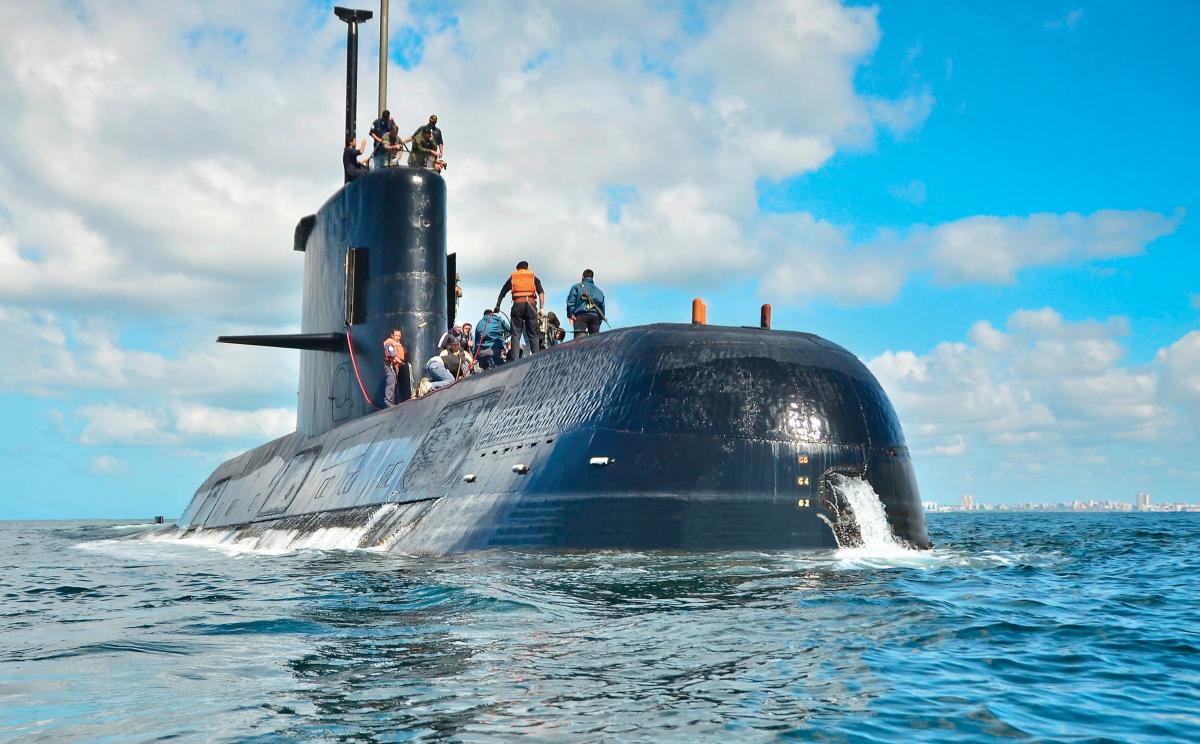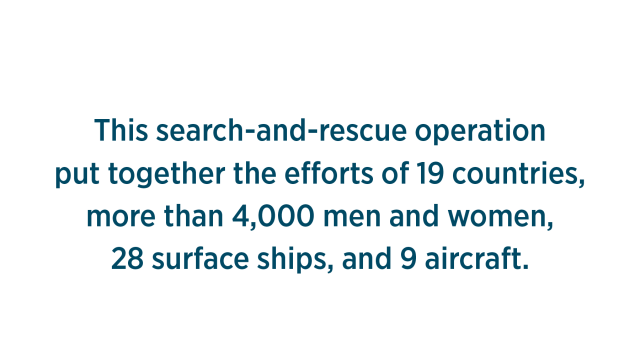The last message from the San Juan was received at 0719 (local time) on 15 November 2017. The submarine was on a peacetime patrol near the limit of the Argentinian exclusive economic zone, some 240 nautical miles off the Patagonian city of Comodoro Rivadavia.
The disappearance of, search-and-rescue (SAR) operation for, and final confirmed identification of the ARA San Juan was a significant event given its duration, the extent of the operations involved, and the prompt aid and support provided by the international community.
Built in Germany in 1983, the San Juan was a TR-1700–class diesel-electric submarine designed by former Thyssen Nordseewerke. She completed a midlife overhaul at Complejo Industrial Naval Argentino, a Buenos Aires shipyard, in 2014.
On the night of 14 November 2017, facing rough seas, the commanding officer reported a water entry (apparently through the snorkel) that had caused a short circuit in the forward battery compartment. A fire followed, but it was controlled by the crew. The San Juan then was ordered to change course and return directly to her home port, Mar del Plata. As specified by established protocol, when she was not heard from, an extensive radio search in all frequencies was performed.
On 16 November at 1413, the Navy transmitted a “submarine missing” message, which triggered the SAR operation. That same day, the ARA La Argentina (a MEKO-360–class frigate carrying a helicopter) was deployed to the San Juan’s estimated position. Later that day, at 1840, an Argentine Navy S-2T Tracker aircraft arrived at the zone and began a visual and radar search. The exploration continued through the night with a Navy Beechcraft B-200 aircraft. Subsequently, most of the Argentine Navy fleet was sent to the area.
On 17 November at 1008, the International Submarine Escape and Rescue Liaison Office protocol alarm for a missing submarine was activated. The submarine force commander then gave the bad news to the relatives of the 44 crewmembers.
Despite bad weather, ships and aircraft from the Argentine Navy, Air Force, and Coast Guard were deployed. The Argentine Army helped with specialists who analyzed satellite images. By coincidence, a U.S. Navy P-3 Orion was stationed in Ushuaia (southern Argentina), working for the U.S. National Aeronautics and Space Administration. It was immediately deployed to carry out search flights. The objective was clear: locate the ARA San Juan and her crew as soon as possible.
Russia, the United Kingdom, and many other nations soon offered assistance. In Puerto Belgrano—home of the Argentine Navy’s main naval base—a special international work team was created. Aside from the Argentinian military, it included experts from the above-mentioned countries and Ministry of Defense officials. They worked together evaluating the available information and planning and coordinating the search effort.
On 22 November, the Comprehensive Nuclear Test-Ban Treaty Organization announced that on 15 November three stations had received an unusual hydroacoustic signal near the missing submarine’s last-known position. The system detected a short, impulsive, broadband signal in a low-frequency spectrum not audible to humans. All details and data were available to support the ongoing operations.
Following the SAR protocol established by the Submarine Escape and Rescue working group, the U.S. Navy Undersea Rescue Command dispatched C-5 Galaxy and C-17 Globemaster transport aircraft with rescue equipment to Argentina. The Norwegian-flagged offshore supply ships Skandi Patagonia and Sophie Siem were also sent.
On 30 November at 1620, the rescue part of the SAR mission formally ended, though a decision was made to continue search operations with all available means. More than 550,000 square nautical miles in the South Atlantic’s rough waters were investigated, but no trace of the submarine was found.
International assistance continued, and more than 100 underwater contacts were explored. The HMS Protector and the research vessels Atlantis (United States), Cabo de Hornos (Chile), and Almirante Maximiano (Brazil) continued to monitor the ocean depths.
Early in December the Russian Navy’s research vessel Yantar joined the search. The Yantar carries advanced equipment and has the ability to inspect objects at depths up to 6,000 meters. Russia also provided the Argentine Navy with a Panther Plus remotely operated vehicle (ROV), to be installed on board a surface ship. In the following four months the Yantar detected and inspected 30 additional contacts.
Once the international support reasonably ended, a search with only Argentinian surface vessels continued until September 2018. Then the Argentine Navy contracted Ocean Infinity, a company specializing in seabed exploration. This firm hired the OSS Seabed Constructor, which was equipped with five autonomous underwater vehicles and two additional remotely operated devices. More than 8,000 square nautical miles were swept in the ensuing 62 days, and 24 new contacts were analyzed.
At last, on 17 November—one year and two days after the San Juan went missing—the Argentine Navy announced the wreckage had been found close to the position of the hydroacoustic anomaly, at a depth of approximately 900 meters. The first images of the sunken submarine were shown. The hull was in a single piece but was crushed by the water pressure. Some pieces of the submarine were scattered across a small area of approximately 80 to 100 meters. The identification was made using a Seabed Constructor’s ROV.
The following day, the President of Argentina declared a national day of mourning in remembrance of the 44 crewmembers of the San Juan, now on eternal patrol.
This SAR operation—unprecedented in recent times—included the efforts of 19 countries, more than 4,000 men and women, 28 surface ships, and 9 aircraft equipped with state-of-the-art technology. It was the most critical situation for the Argentine Navy since the Malvinas conflict in 1982 and far exceeded current contingency plans.
Our special gratitude goes to the nations and navies involved for their efforts and support during the SAR operations, as well as the countless expressions of solidarity for and remembrance of the 44 San Juan submariners.




